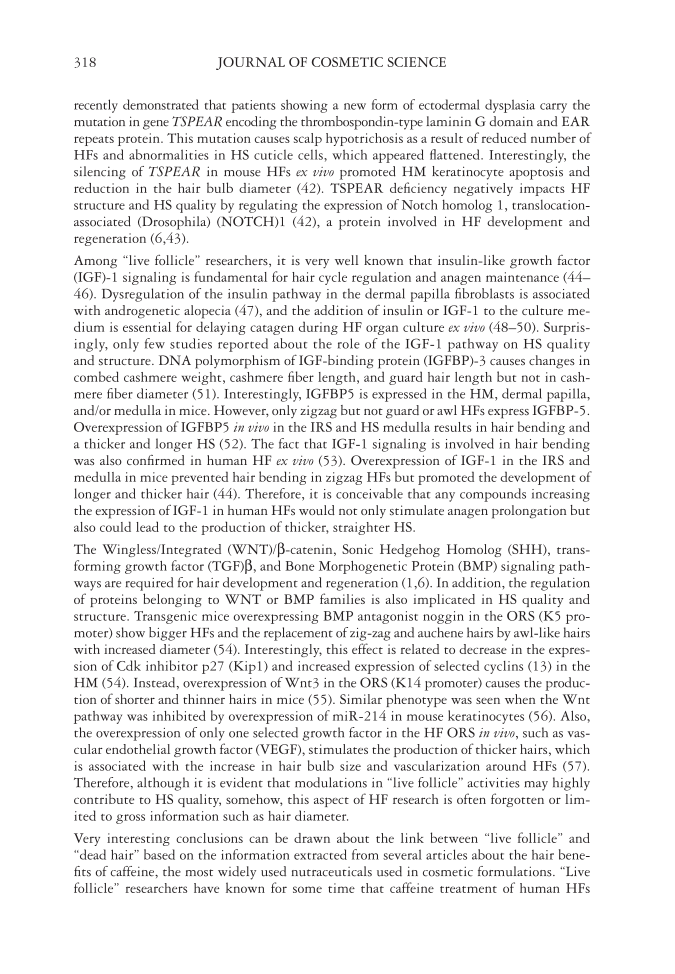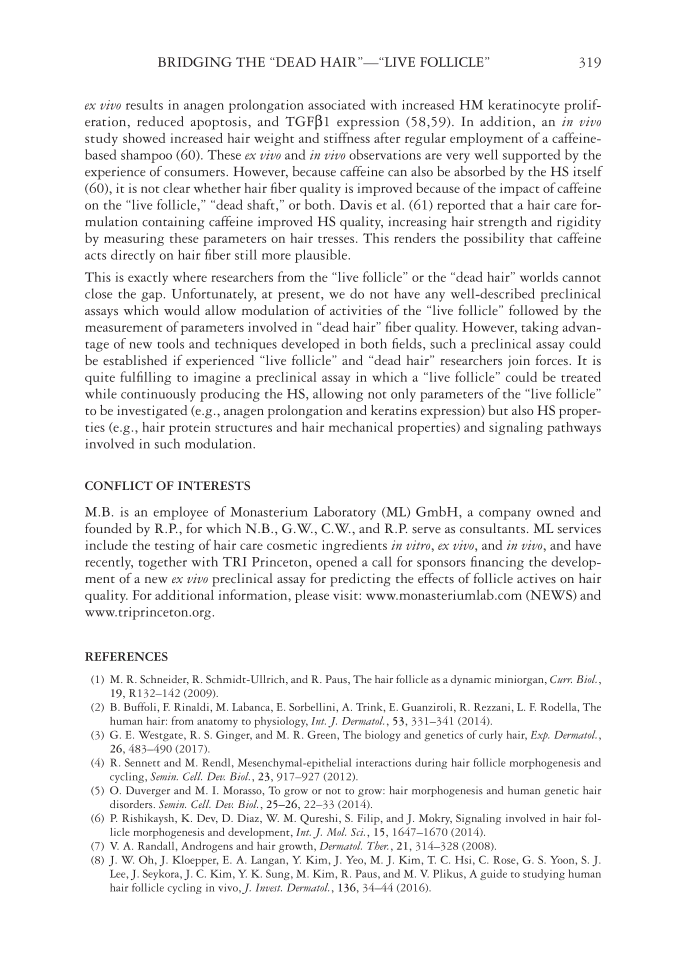JOURNAL OF COSMETIC SCIENCE 318 recently demonstrated that patients showing a new form of ectodermal dysplasia carry the mutation in gene TSPEAR encoding the thrombospondin-type laminin G domain and EAR repeats protein. This mutation causes scalp hypotrichosis as a result of reduced number of HFs and abnormalities in HS cuticle cells, which appeared fl attened. Interestingly, the silencing of TSPEAR in mouse HFs ex vivo promoted HM keratinocyte apoptosis and reduction in the hair bulb diameter (42). TSPEAR defi ciency negatively impacts HF structure and HS quality by regulating the expression of Notch homolog 1, translocation- associated (Drosophila) (NOTCH)1 (42), a protein involved in HF development and regeneration (6,43). Among “live follicle” researchers, it is very well known that insulin-like growth factor (IGF)-1 signaling is fundamental for hair cycle regulation and anagen maintenance (44– 46). Dysregulation of the insulin pathway in the dermal papilla fi broblasts is associated with androgenetic alopecia (47), and the addition of insulin or IGF-1 to the culture me- dium is essential for delaying catagen during HF organ culture ex vivo (48–50). Surpris- ingly, only few studies reported about the role of the IGF-1 pathway on HS quality and structure. DNA polymorphism of IGF-binding protein (IGFBP)-3 causes changes in combed cashmere weight, cashmere fi ber length, and guard hair length but not in cash- mere fi ber diameter (51). Interestingly, IGFBP5 is expressed in the HM, dermal papilla, and/or medulla in mice. However, only zigzag but not guard or awl HFs express IGFBP-5. Overexpression of IGFBP5 in vivo in the IRS and HS medulla results in hair bending and a thicker and longer HS (52). The fact that IGF-1 signaling is involved in hair bending was also confi rmed in human HF ex vivo (53). Overexpression of IGF-1 in the IRS and medulla in mice prevented hair bending in zigzag HFs but promoted the development of longer and thicker hair (44). Therefore, it is conceivable that any compounds increasing the expression of IGF-1 in human HFs would not only stimulate anagen prolongation but also could lead to the production of thicker, straighter HS. The Wingless/Integrated (WNT)/β-catenin, Sonic Hedgehog Homolog (SHH), trans- forming growth factor (TGF)β, and Bone Morphogenetic Protein (BMP) signaling path- ways are required for hair development and regeneration (1,6). In addition, the regulation of proteins belonging to WNT or BMP families is also implicated in HS quality and structure. Transgenic mice overexpressing BMP antagonist noggin in the ORS (K5 pro- moter) show bigger HFs and the replacement of zig-zag and auchene hairs by awl-like hairs with increased diameter (54). Interestingly, this effect is related to decrease in the expres- sion of Cdk inhibitor p27 (Kip1) and increased expression of selected cyclins (13) in the HM (54). Instead, overexpression of Wnt3 in the ORS (K14 promoter) causes the produc- tion of shorter and thinner hairs in mice (55). Similar phenotype was seen when the Wnt pathway was inhibited by overexpression of miR-214 in mouse keratinocytes (56). Also, the overexpression of only one selected growth factor in the HF ORS in vivo, such as vas- cular endothelial growth factor (VEGF), stimulates the production of thicker hairs, which is associated with the increase in hair bulb size and vascularization around HFs (57). Therefore, although it is evident that modulations in “live follicle” activities may highly contribute to HS quality, somehow, this aspect of HF research is often forgotten or lim- ited to gross information such as hair diameter. Very interesting conclusions can be drawn about the link between “live follicle” and “dead hair” based on the information extracted from several articles about the hair bene- fi ts of caffeine, the most widely used nutraceuticals used in cosmetic formulations. “Live follicle” researchers have known for some time that caffeine treatment of human HFs
BRIDGING THE “DEAD HAIR”—“LIVE FOLLICLE” 319 ex vivo results in anagen prolongation associated with increased HM keratinocyte prolif- eration, reduced apoptosis, and TGFβ1 expression (58,59). In addition, an in vivo study showed increased hair weight and stiffness after regular employment of a caffeine- based shampoo (60). These ex vivo and in vivo observations are very well supported by the experience of consumers. However, because caffeine can also be absorbed by the HS itself (60), it is not clear whether hair fi ber quality is improved because of the impact of caffeine on the “live follicle,” “dead shaft,” or both. Davis et al. (61) reported that a hair care for- mulation containing caffeine improved HS quality, increasing hair strength and rigidity by measuring these parameters on hair tresses. This renders the possibility that caffeine acts directly on hair fi ber still more plausible. This is exactly where researchers from the “live follicle” or the “dead hair” worlds cannot close the gap. Unfortunately, at present, we do not have any well-described preclinical assays which would allow modulation of activities of the “live follicle” followed by the measurement of parameters involved in “dead hair” fi ber quality. However, taking advan- tage of new tools and techniques developed in both fi elds, such a preclinical assay could be established if experienced “live follicle” and “dead hair” researchers join forces. It is quite fulfi lling to imagine a preclinical assay in which a “live follicle” could be treated while continuously producing the HS, allowing not only parameters of the “live follicle” to be investigated (e.g., anagen prolongation and keratins expression) but also HS proper- ties (e.g., hair protein structures and hair mechanical properties) and signaling pathways involved in such modulation. CONFLICT OF INTERESTS M.B. is an employee of Monasterium Laboratory (ML) GmbH, a company owned and founded by R.P., for which N.B., G.W., C.W., and R.P. serve as consultants. ML services include the testing of hair care cosmetic ingredients in vitro, ex vivo, and in vivo, and have recently, together with TRI Princeton, opened a call for sponsors fi nancing the develop- ment of a new ex vivo preclinical assay for predicting the effects of follicle actives on hair quality. For additional information, please visit: www.monasteriumlab.com (NEWS) and www.triprinceton.org. REFERENCES (1) M. R. Schneider, R. Schmidt-Ullrich, and R. Paus, The hair follicle as a dynamic miniorgan, Curr. Biol., 19, R132–142 (2009). (2) B. Buffoli, F. Rinaldi, M. Labanca, E. Sorbellini, A. Trink, E. Guanziroli, R. Rezzani, L. F. Rodella, The human hair: from anatomy to physiology, Int. J. Dermatol., 53, 331–341 (2014). (3) G. E. Westgate, R. S. Ginger, and M. R. Green, The biology and genetics of curly hair, Exp. Dermatol., 26, 483–490 (2017). (4) R. Sennett and M. Rendl, Mesenchymal-epithelial interactions during hair follicle morphogenesis and cycling, Semin. Cell. Dev. Biol., 23, 917–927 (2012). (5) O. Duverger and M. I. Morasso, To grow or not to grow: hair morphogenesis and human genetic hair disorders. Semin. Cell. Dev. Biol., 25–26, 22–33 (2014). (6) P. Rishikaysh, K. Dev, D. Diaz, W. M. Qureshi, S. Filip, and J. Mokry, Signaling involved in hair fol- licle morphogenesis and development, Int. J. Mol. Sci., 15, 1647–1670 (2014). (7) V. A. Randall, Androgens and hair growth, Dermatol. Ther., 21, 314–328 (2008). (8) J. W. Oh, J. Kloepper, E. A. Langan, Y. Kim, J. Yeo, M. J. Kim, T. C. Hsi, C. Rose, G. S. Yoon, S. J. Lee, J. Seykora, J. C. Kim, Y. K. Sung, M. Kim, R. Paus, and M. V. Plikus, A guide to studying human hair follicle cycling in vivo, J. Invest. Dermatol., 136, 34–44 (2016).
Purchased for the exclusive use of nofirst nolast (unknown) From: SCC Media Library & Resource Center (library.scconline.org)









































































































